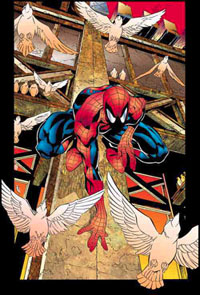|
|
Some material adapted from White Wolf Game Studio's Aberrant RPG and Street Fighter: The Storytelling Game
In this section, you'll find a few sample story concepts to give you ideas of your own. Keep in mind that many of the stories you can create can combine one or more of these story concepts, or use completely different ideas.
Heroes Unlimited games need not be limited to straight-out hero-versus-villain slugfests. Incorporate moral dilemmas, detective work, and real-life decisions. If run well, your game sessions can (and, if you ask me, should) quickly become much more complex than the standard of waiting for the villain to strike and defeating him.
Most stories should fit into the type of campaign you are running, to create continuity from story to story, but don't feel limited. You can always throw in one or two oddball stories that don't really fit into your main storyline. It's good to keep the players guessing what's going to happen next, as long as you don't stray too far for too long.
Plus, he does whatever a spider can. Except shoot webs out of his butt. That, and his wife doesn't devour him after sex.
There are hundreds of possible story hooks for a Heroes Unlimited campaign, and your characters' backgrounds and personalities should lend themselves to dozens more. From stories that take place before the characters' origins (a sort of a prologue) to the final conflict between the characters and their worst enemies, the possibilities are virtually endless. This section's ideas are only the tip of the iceberg, but if you've never GM'ed a Heroes Unlimited (or any other superhero RPG) game before, they might offer a good starting point.

Spidey here isn't just about finding the villians and defeating them, is he? Nope. He has human problems, too. He has bills, marital spats, and family commitments, not to mention his day job and that bastard J. Jonah Jameson.
Once you have a story concept in mind, go ahead and flesh it out into an outline of the plot. Try to work out the basics in your mind, or at least write them down on paper. Take a close look at your plot; see if there are areas where you can add more suspense, or cool settings, or unexpected plot twists, or more opportunities for the characters' decisions to affect the outcome of the adventure.
This next part is really important, so read carefully:
Do create a plot that can only have one ending.
The purpose of a role-playing game is to create the story as you play. As the GM, you only need an outline of what you think might happen during the game session. Don't trap your players in a pre-made plot that can only have one outcome, no matter what the characters do. The players are bound to miss clues you thought were obvious, or solve some mysteries before you thought they would, anyway. Your plot will inevitably change depending on what the players decide to do or not do.
After you have a plotline in mind, go ahead and create the NPC's you'll need for the adventure. Jot down some notes describing the settings you think the characters will visit during the adventure, such as a street corner, a research laboratory, or a supervillain's secret lair. You should compile enough notes to be comfortably able to run the game in front of your players. Some GM's make lots of notes and detailed maps before running a game, others make only brief notes and create many of the details "on the fly," during the course of the game session. Figure out which way works best for you (personally, I'm a "less notes, more action" kind of GM).
The process can be summarized as follows:
- Plot: Choose a story concept/idea.
- Setting: The plot should (but won't always) help to determine just where the story will take place. Does it happen in a single place, or do the characters have to travel to different locales over the course of the adventure?
- Atmosphere: You should determine the atmosphere/mood you want for the story. The plot and setting will usually help formulate this: You don't want a dark, forboding atmosphere for a romantic story set in the Bahamas, but such an atmosphere would benefit a mystery set on the misty moors of Scotland.
- Break the story into scenes/sections: Once you've decided on all of the above, you can lay out your story into scenes; Think of it a sort of a "storyboard" where you figure out what order you'd like the events in the story to happen. When characters leave one area and go to another, such as leaving the wharves to go to the villain's underground lair, the scene changes. The passage of time can also change a scene. Don't get fixated on scenes, though; They are mainly an organizational tool. They are moments or building suspense or releasing tension. Next time you read a book or watch a movie, pay careful attention to where the scene changes. Note how the author/screenwriter used a change in time or location to enhance the story.
Okay, then... now you're prepared to run a game session. Good luck, and remember: Your goal is to entertain and challenge not only yourself, but also your players.
When you finish running your adventure, try to decide which story elements you (and the rest of the group) liked and want to keep in the campaign, and keep your notes on those villains, characters and settings you might want to use again.
MAIN | Disaster | Espionage | Exploration | Mystery | Rescue/Recovery | Revenge